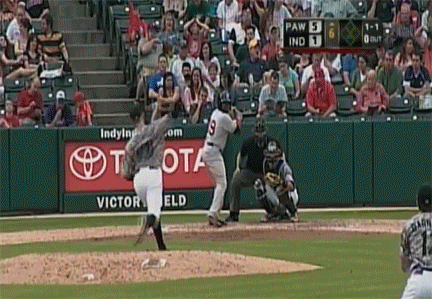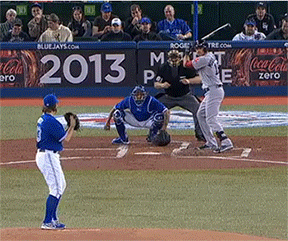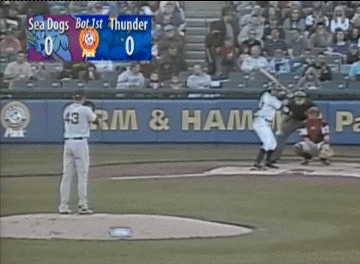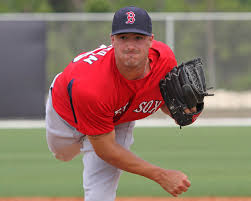This Saturday and Sunday I caught the Pawtucket Red Sox on the road against the Buffalo Bisons. The matchup of the Red Sox and Blue Jays AAA affiliates featured several of the top prospects in the Red Sox organization with the following members of Marc Hulet’s preseason Top 15 Red Sox prospects on the Pawtucket roster: #1 Xander Bogaerts, #3 Jackie Bradley Jr., #4 Allen Webster, #10 Brandon Workman, #12 Bryce Brentz and #14 Anthony Ranaudo. Additionally, 2012 #2 Will Middlebrooks manned the hot corner for Pawtucket. Bogaerts at #2, JBJ at #38, and Ranaudo at #49 also appeared on Hulet’s 2013 midseason top 50 list.
I offer the following (perhaps voluminous) review for your reading pleasure. Furthermore, I included the following images and GIFs for your viewing pleasure.
 (Image from Milb.com)
(Image from Milb.com)
Xander Bogaerts: The Red Sox wisely held onto Bogaerts this trade deadline, the crown jewel of their farm system, and the consensus top shortstop prospect in baseball. The 20 year-old has thrived following a promotion to AAA, with a .282/.378.477 line in 47 games along with a .387 wOBA and 139 wRC+, despite a BABIP% of .311, 31 points lower than his minor league career average. Impressively, the youngster has posted a 12.4 BB%, and has actually cut his strikeout rate from 21.6% to 16.9% after being promoted from AA to AAA. Bogaerts has excellent bat speed and real power, and hit a couple balls hard the other way, including a fly ball to the wall in right-center. While Bogaerts appeared to recognize off-speed pitches well, he swung through several breaking balls, including three straight in one poor at-bat. Improved patience will be key for Bogaerts to realize his full potential at the next level.
Tall and lean at 6’3 and 185 pounds, Bogaerts looked smooth at the shortstop position. He flashed some nice range making a sliding backhand play and putting plenty on the throw to first. While he may eventually outgrow the position his defense is sufficient for the major-league level. In the best-case scenario, Bogaerts provides elite-level offense combined with solid defense from the shortstop position a la Troy Tulowitzki or a young Nomar Garciaparra. Bogaerts may have the opportunity to make a Manny Machado-like impact as a late-season call-up. With Stephen Drew being a free agent this offseason, Bogaerts will likely have the opportunity to win the Red Sox starting shortstop job in 2014, which would be his age-21 season. Nomar Garciaparra, the last great Sox shortstop, took over the position full-time in his age-23 season.
 (overthemonster)
(overthemonster)
Jackie Bradley Jr.: An outstanding spring earned Bradley Jr. a starting spot in left field for the Red Sox. He then promptly reminded fans how little spring stats mean, as he has posted a .155/.258/.310 slash line, with a .259 wOBA and 54 wRC+, compiling a -0.4 fWAR in 23 games. A 30.3 K% hampered him in 66 PA with the Sox. Fortunately, his minor league stats have shown much more promise, as he is currently at .278/.378/.489 with a .388 wOBA and 140 wRC+ with Pawtucket. Bradley Jr. has also exhibited good patience with a 12.3 BB%. Plate discipline has been a strength of Bradley Jr’s. game, as he has posted a 14.0 BB% and a 16.7 K% over his minor league career. While his career minor league BABIP% of .350 will likely fall some at the big league level, it will certainly be higher than the .194 this year, with his true talent likely being in the .310 range. Though Bradley is only 31/46 in stolen bases for his professional career, scouts have noted his base running chops. Additionally, his speed, range, throwing arm and instincts give him the potential to be a plus defender. With the likely departure of Jacoby Ellsbury this offseason, JBJ will have every chance to win a starting spot in 2014.
 (GIF from SBNation)
(GIF from SBNation)
Will Middlebrooks: Middlebrooks burst onto the scene last year, offering a bright spot for the Red Sox during a mostly dismal 2012 campaign. He slashed his way to .288/.325/.509 with a .357 wOBA and 122 wRC+ compiling 1.9 fWAR before a broken bone in his hand ended his season after 75 games. These numbers may have obscured his plate-discipline issues, as his strikeout and walk percentages were 24.5% and 4.5%, respectively. However, 2013 has not been so kind to Middlebrooks, who was sent down on June 25. At the time of his demotion, he was .192/.228/.389 with a woeful .266 wOBA and 60 wRC+, posting a -0.6 fWAR. His K% increased to 27.8%, with his BB% at 4.2%. A major culprit of his struggles are BABIP-related. In 2012 his xBABIP% was .336, and his actual BABIP% was .335. This neat symmetry has been dashed in 2013 as his xBABIP% is .327, a far cry from the .221 he has experienced. Furthermore, his struggles have been compounded by a HR/FB % that has dropped from 21.4 to 15.0 despite his average fly ball distance experiencing a small increase from 278.9 to 280.4. Middlebrooks’ batted ball profile suggests that his poor offensive numbers are due for a positive correction. In 40 AAA games Middlebrooks has shown improved contact skills, posting a K% of 18.8% with a BB% of 8.0%, improvements on his career minor league rates of 25.6% and 7.5%. He showed more patience at the plate when I saw him, laying off several breaking balls, and pouncing on a hanger. His BABIP% of .281, compared to his minor league career average of .346, has limited him to a solid but unspectacular .339 wOBA and 107 wRC+. Middlebrooks showed a strong arm and good athleticism and footwork at third, but he occasionally gets sloppy on his throws and his range to his left could be improved.
While Middlebrooks’ stock may have fallen with his struggles in the majors this year, and less than great AAA results, Red Sox fans should not lose faith. His stellar results in 75 games in 2012 may have caused some fans/personnel to gloss over his raw plate approach. While pitchers seemed to do a better job of exploiting that weakness before Middlebrooks’ demotion in 2013, at least some of his poor results can be attributed to a .221 BABIP. His contact rate in AAA has been an improvement on his career minor-league numbers, and despite fewer of those balls in play going for hits, he has managed decent numbers. If Middlebrooks can hold a K% and BB% around 20% and 6-7% at the next level, he should be a very productive player for the Red Sox, as his BABIP% will likely undergo positive regression to go along with his excellent power.
 (Image from overthemonster)
(Image from overthemonster)
Allen Webster: Webster had a rough go of it over six starts at the big-league level, as the 23-year-old right-hander posting a 9.57 ERA in 26.1 innings with 21 strikeouts and 14 walks and a whopping 7 home runs. While his DIPS numbers were less awful, his 6.57 FIP and 5.07 xFIP earned him a -0.3 fWAR. Nevertheless, Webster showed some promise. Despite a strikeout rate of only 16.4%, Webster’s contact rate was only 71%, well below the MLB average of 78%. When I saw Webster June 28 against Toronto, I was impressed by his fastball, which ranged from 92-97 with sinking action that produced lots of ground balls. In six starts his GB% is 41.8. For the season, his fastball has averaged 94.1 mph, which is 18th highest among pitchers with 20 or more innings. His changeup, which he throws 26.8% of the time is his favorite secondary offering. At an average of 85.3 mph there is good separation from the fastball, and it showed good depth and tilt. His slider, which he throws only 9.8% of the time looked promising, with some late bite. It averages 84.5 mph. He mixed in a couple curveballs at 77mph, but this looked like more of a show-me pitch than something Webster can feature. Generally Webster had a smooth, clean delivery, and his 6’3 frame allowed him to get a good plane on his pitches. His release point faltered as he tired in the 5th and 6th innings. Webster’s control and command will have to progress to realize his potential as a starting pitcher, as his professional walk rate of 10% is on the high side. If Webster can lower his walks and import his minor league 22.3 K% and 3.09 FIP, he could be the Red Sox #2/3 pitcher. If not, his fastball velocity will likely slot him into a high-leverage relief role.
 (GIF from SBNation)
(GIF from SBNation)
Anthony Ranaudo: The 6’7 225 right-hander from LSU was the 39th overall pick for the Sox in 2010. After posting a 2.95 ERA, 3.51 FIP, 24.0 K%, and 9.7 BB% in 109.2 AA innings, he earned a promotion to AAA. I caught Ranaudo’s first AAA start, and he went 6 shutout innings with 5 strikeouts and no walks, throwing 85 pitches, 56 for strikes. His fastball was in the 89-92 range, and gets up to 94. It had good sink and a downward plane and produced lots of ground balls. He features a curveball at 75-79 with good downward break as this grainy GIF shows. His changeup could develop into above-average pitch, but is currently an inconsistent offering. Ranaudo’s stock has risen significantly after a lackluster 2012 in AA where he walked 27 hitters in 37.2 innings before having his season shut down due to injuries. If his shoulder and elbow hold up, Ranaudo could be a solid #3 starter at the next level.
 (Image from mlblogs.com)
(Image from mlblogs.com)
Brandon Workman: The tall right-hander was optioned to Pawtucket following the acquisition of Jake Peavy. In 4 appearances at the big-league level (3 starts) and 20.1 innings, Workman posted a 3.54 ERA with a 2.75 FIP and 3.11 xFIP, accumulating 0.7 fWAR. Additionally, Workman had stellar strikeout and walk rates at 26.8% and 4.9%, respectively. His repertoire consists of a fastball which has averaged 91.8 mph, and a cutter, curveball, and changeup, which have improved to become average to above-average pitches. Workman has had consistent success throughout the minors, with a 23.4 K%, 6.9 BB% and 3.33 FIP. Moreover, he has been durable, throwing nearly 400 professional innings over 2+ seasons. While Workman will be pitching out of the bullpen in Pawtucket with the possibility of returning to the majors in that role down the stretch, long term he projects as a quality back-end innings eater. At his worst he is probably a lower-leverage bullpen arm.
 (Image from randombaseballstuff)
(Image from randombaseballstuff)
Bryce Brentz: A power-hitting outfield prospect for the Sox, Brentz is likely to miss the remainder of the season following right-knee surgery to repair a torn meniscus suffered on a slide into second base July 5th. Brentz also missed spring training in 2013 after accidentally shooting himself in the leg. Prior to the knee injury Brentz had a slash line of .272/.321/.487 with a .359 wOBA and 120 wRC+. Brentz’s biggest weakness is recognizing breaking balls, and he has posted 2013 strikeout and walk rates of 23.5% and 5.9%, respectively. His impressive minor-league stats are fueled in part by a career .332 BABIP, which is likely to fall to the .260 range at the major-league level. Brentz is not a great runner, and the knee surgery will likely affect his slightly below-average range. A former two-way player, Brentz does feature a very strong arm which resulted in 10 outfield assists in 87 games in 2012. Brentz is unlikely to post high walk rates, so future big league success will depend heavily on tapping into his impressive raw power while keeping his strikeout rate from ballooning above the 20-25% range.
—
Stats provided by Baseball-Reference, FanGraphs, and baseballheatmaps.com. Thanks to Marc Hulet’s prospect rankings for additional insights.

 (muckracker)
(muckracker) (From Forbes to Federal)
(From Forbes to Federal)


 (overthemonster)
(overthemonster) (GIF from SBNation)
(GIF from SBNation) (GIF from SBNation)
(GIF from SBNation)